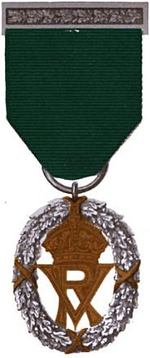Volunteer Officers' Decoration
| Volunteer Officers' Decoration | |
|---|---|
|
Volunteer Officers' Decoration, first version | |
| Awarded by the United Kingdom | |
| Type | Military decoration |
| Eligibility | "Efficient and thoroughly capable" officers of the Volunteer Force |
| Awarded for | Military service of twenty years (eighteen for those serving in India) |
| Status | Superseded in the UK by the Territorial Decoration |
| Description | Oak wreath decoration in silver tied with gold, having in the centre the royal cipher and crown in gold, suspended from the left breast by a plain dark green riband of one inch and a half (38mm) in width from a silver oak bar-brooch.[1] |
| Post-nominals | V.D. |
| Statistics | |
| Established | 1892 (25 July) |
| First awarded | 1892 (15 Nov) |
| Last awarded | 1907 |
| Precedence | |
| Next (higher) | Army Emergency Reserve Decoration[2] |
| Next (lower) | Volunteer Long Service Medal[2] |
| Related |
Colonial Auxiliary Forces Officers' Decoration Volunteer Reserves Service Medal |
|
Volunteer Officers' Decoration ribbon | |
The Volunteer Officers' Decoration (V.D.), sometimes just referred to as the Volunteer Decoration, was instituted in 1892 to reward the "long and meritorious services of Officers of proved capacity in Our Volunteer Force"[1] in Great Britain, and then extended in 1894 to include commissioned officers of all Volunteer Forces throughout the British Empire.[3] The qualifying period was 20 years of service (excepting in India, where the period was only 18 years), with half of any previous years' service in the Regular Army also counting towards qualification. The award did not confer any individual precedence but entitled the recipient to use the postnominal letters V.D. after their name.[4] It was superseded in the colonies and India by other medals in 1899, and within the UK by the Territorial Decoration (T.D.) in 1908.
From 1892: for service in the UK
The Volunteer Officers' Decoration was created by Royal Warrant under command of Queen Victoria on 25 July 1892 to reward 'efficient and thoroughly capable' officers of the Volunteer Force in Great Britain who had served for 20 years, with half of any time during which a Volunteer Force officer had served in the Regular Army to be counted as qualifying service towards the 20 years required.[1] Recipients had to have been recommended by the Commanding Officer of their Corps, and duly certified by the District Military Authorities in which the Corps was located "as having been an efficient and thoroughly capable Officer, in every way deserving of such a decoration". It was further stipulated that "In order to make such additional provision as shall effectually preserve pure this most honourable distinction, it is ordained, that if any person on whom it shall be conferred be convicted of any act derogatory to his honour as an Officer and gentleman, his name shall forthwith be erased from the registry of individuals upon whom the said Decoration shall have been conferred," with a notification thereof duly published in the London Gazette.[1]
From 1894: for service throughout the Empire
On 24 May 1894 the grant of the decoration was extended by Royal Warrant to officers of Volunteer Forces throughout the British Empire, defined as being India, the Crown colonies and the Crown dependencies, with the same terms and conditions applying except that in the case of India the length of qualifying service was set at 18 years. The names of overseas officers granted the decoration or removed from the registry were not published in the London Gazette but instead published in the Official Gazette of India or of the relevant colony or dependency.[3] Medals for Colonial and Indian officers were issued with the letters "VRI" (Victoria Regina Imperatrix) in place of "VR".
1899-1930: Supercedence
The Volunteer Officers' Decoration was superseded in the colonies in 1899 by the Colonial Auxiliary Forces Officers' Decoration[5] and the Indian Volunteer Forces Officers' Decoration. The Colonial Auxiliary Forces Officers' Decoration was instituted by Royal Warrant on 18 May 1899 and amended by further Warrants on 3 August 1902 and 9 June 1921. Recipients of the Colonial Auxiliary Forces Officers' Decoration were, as with the previous award, allowed to use the postnomial V.D.[4]
Upon the formation of the Territorial Force in 1908, the Volunteer Officers' Decoration was superseded in Great Britain by the Territorial Decoration (T.D.). However the Volunteer Officers' Decoration continued to be awarded in some dependencies, Bermuda being the last to award it until superseded there by the Efficiency Decoration (Territorial and TAVR) (TD) in September 1930.
Only about 4,700 awards were made over the entire life of the Volunteer Officers' Decoration.[6] The total of V.D. awards including Colonial Auxiliary Forces / Indian Forces medals was far greater, the number of decorations awarded to Canadians for example being, by reign: Queen Victoria ("VRI") 850; King Edward VII ("ERI VII") 250; King George V ("GRV") 1,660.[7]
See also
- London Gazette#Colonial gazettes
References
- ↑ 1.0 1.1 1.2 1.3 The London Gazette: no. 26311. p. 4303. 29 July 1892.
- ↑ 2.0 2.1 The London Gazette: (Supplement) no. 56878. p. 3352. 17 March 2003.
- ↑ 3.0 3.1 The London Gazette: no. 26516. p. 3115. 26 May 1894.
- ↑ 4.0 4.1 The London Gazette: no. 33049. p. 3446. 22 May 1925.
- ↑ The London Gazette: no. 27085. p. 3517. 2 June 1899.
- ↑ "Volunteer Officer’s Decoration, George V issue, miniature". www.medal-medaille.com. Retrieved 22 March 2013.
- ↑ "Colonial Auxiliary Forces Officers' Decoration - Canadian Military Medals and Decorations". Veterans Affairs Canada. Retrieved 22 March 2013.
